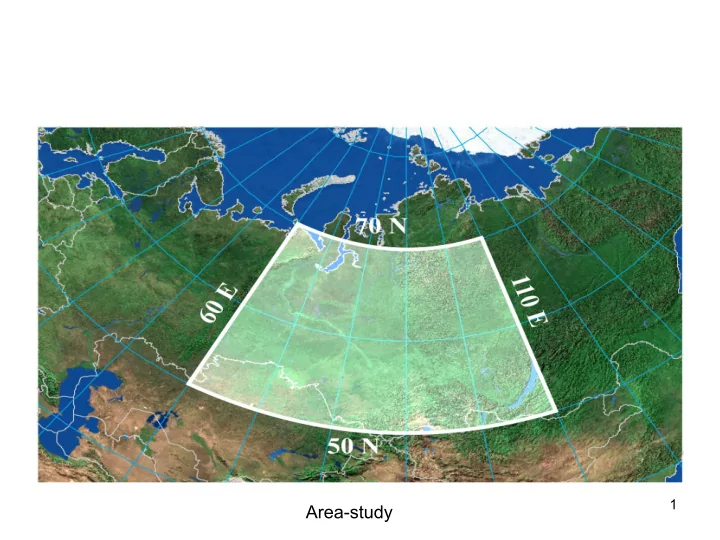

1 Area-study
DATA • the daily observational data (ftp://ftp.cdc.noaa.gov/pub/data/gsod/) at 169 stations during 1976–2006 • the SCAND, NAO and ENSO teleconnection indices (http:// www.cpc.ncep.noaa.gov) describing the global circulation • 6-hours surface synoptic maps from the archive of West-Siberian Interregional territorial Administration of Federal Service for Hydrometeorology and Environmental Monitoring (West-Siberian AHEM) • 6-hours data from Reanalysis 20th Century v2 during 1891–2008 (http://www.esrl.noaa.gov/psd/data/gridded/data.20thC_ReanV2.html) 2
The Influence of Atmospheric Circulation on the Temperature Regime of Siberia at the time of Current Global Warming 1 Ippolitov I.I., 2 Gorbatenko V.P., 1 Kabanov M.V., 1 Loginov S.V., 1 Podnebesnych N.V. 1 Institute of Monitoring of Climatic and Ecological Systems, SB RAS, Tomsk, Russia 2 High voltages research institute at Tomsk Polytechnic University, Tomsk, Russia
The spatial distribution of annual temperature trend T tr ( 0 C/decade) on Siberian region in 1976-2006 169 Station 4 The distribution function of T tr The probability density function of T tr
-0,5 T=0.036 t – 2.49 y = 0,023x - 2,8523 Spatial averaged temperature T, oC -1,0 -1,5 -2,0 -2,5 -3,0 -3,5 -4,0 -4,5 -5,0 1976 1979 1982 1985 1988 1991 1994 1997 2000 2003 2006 Year-to-year changes in the spatial averaged annual temperature T and its trend T tr . Trend is significant in terms of 0.05 5
Spatial averaged temperature and its linear trends for each month 6
The selected trajectories of cyclones (I÷VII) entrance to the region ‘Sib’ (white line) 7
75 y = -0,14+48,1 n Z = -0.14 t – 2.85 70 65 Number of Cyclones n Z 60 55 50 45 40 35 30 1976 1978 1980 1982 1984 1986 1988 1990 1992 1994 1996 1998 2000 2002 2004 2006 The total number of cyclones n Z , which income to the region ‘Sib’ by synoptic maps. Trend is significant in terms of 0.05 8
1004 y = -0,02+1000,8 Pc= -0.02 t + 1000 Pressure Centre of Cyclones, hPa 1003 1002 1001 1000 999 998 997 996 1976 1978 1980 1982 1984 1986 1988 1990 1992 1994 1996 1998 2000 2002 2004 2006 Year-to-year changes in the spatial averaged annual pressure centre of cyclones Pc and its trend Pc tr Trend is not significant in terms of 0.05 9
Nz= 0,14 (±0,12) t + 17,6 Nz= -0,21 (±0,07) t + 19,3 40 y = -0,21x + 19,3 y = -0,06x + 10,8 y = 0,14x + 17,6 Nz= -0,06 (±0,09) t + 10,8 35 The Total Number of Cyclones 30 25 20 15 10 5 0 1976 1978 1980 1982 1984 1986 1988 1990 1992 1994 1996 1998 2000 2002 2004 2006 Variability in the number of cyclones for West (blue), North (red) and South (green) direction. The equations of regression are shown 10
wavelet spectra of the Variabilities of cyclones for South (a) and West (b) a) direction. b) 11
Pc= 0,05 (±0,07) t + 994,3 Pc= -0,09 (±0,05) t + 1007,3 y = 0,04x + 998,9 y = -0,09x + 1007,3 1015,0 y = 0,05x + 994,3 Pc= 0,04 (±0,10) t + 998,9 Pressure Centre of Cyclones, hPa 1010,0 1005,0 1000,0 995,0 990,0 985,0 1976 1978 1980 1982 1984 1986 1988 1990 1992 1994 1996 1998 2000 2002 2004 2006 Variability in the pressure centre of cyclones for West (blue), North (red) and South (green) direction. The equations of regression are shown 12
Gulev S.K. et al Climate Dynamics, 2001, 17, 795-809 13
FIG. 9. Time series of cold season cyclone counts (1966/67 to 1992/ 93) for north of 60 0 N (dotted lines) and for 30 0 –60 0 N (dashed lines). To display both time series on the same scale, counts for the 30 0 – 60 0 N zonal band have been divided by two. Serreze M.C. et al J. Climate, 1997 ,v 10, 453 –464 14
The mean climatological locations of zones baroclinity between 1979-2008, obtained by calculating grad T at the grid 995gPa 1.125 ° x 1.125 ° 15 January Jule
Polar low density distribution. Detected polar lows per 250 km 2 16 Matthias Zahn, and Hans von Storch, Geophysical Research Letters, 2008, v. 35, L22702
FIG. 2. The long-term mean cyclone center count in (a) winter and (b) summer. (counts per 10 5 km 2 ) Xiangdong Zhang , et al, Journal of Climate, Volume 17, Issue 12 (June 2004) 2300–2317 17
The mean climatological position of the Arctic and polar fronts between 1979-2008, obtained by calculating grad T at the grid 497gPa 1.125 ° x 1.125 ° 18 January Jule
b) a) FIG. 3. Time series plots of the area-weighted averages over the NH, 20 0 – 70 0 N for a) cyclone count (no. of events), b) MTG Paciorek C. J. et al J. Climate, 2002, v15, 7, 1573-1990
MTG (30,50) MTG (60,80) Polar front Arctic front MTG indices are calculated by data from Reanalysis 20 th Century 20
Table 2 Correlation between temperature and selected teleconnection indices 21
Table 3 Correlation between temperature and selected regional circulation values 22
Coefficient of determination 23
Correlation between temperature and SCAND 24
Correlation between temperature and NAO 25
Correlation between temperature and SOI 26
Thank you for attention! 27
Recommend
More recommend